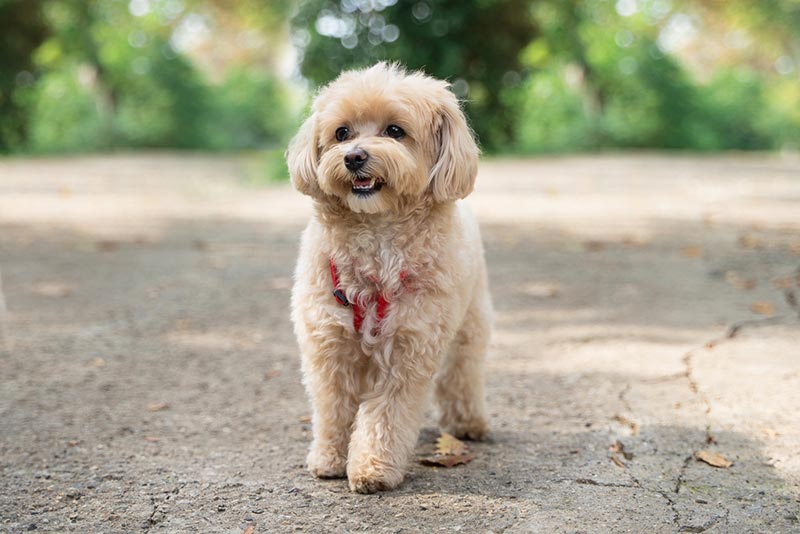How to Groom a Maltese: 10 Expert Tips & Advice
Updated on
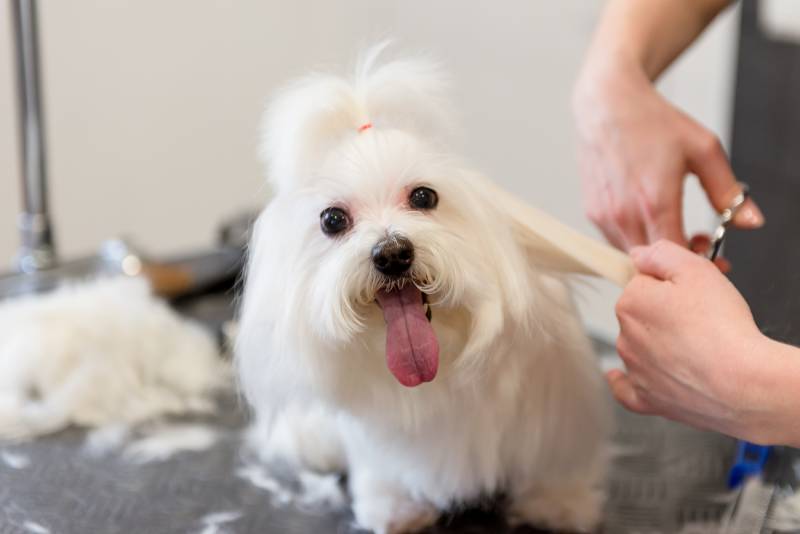
Maltese are eye-catching dogs famous for their gorgeous, long, silky white coats. But if you’re a new Maltese dog parent or are considering bringing one into your family, you might be wondering how hard it is to groom this breed.
Here, we help you through the grooming process, which might prove to be not quite as challenging as you might think. We hope that following these 10 tips will make grooming your Maltese a breeze!
Before You Get Started
It’s important to note that the Maltese is considered hypoallergenic (though there is no such thing as a 100% hypoallergenic dog breed). They do not have an undercoat and shed very little.
That said, the Maltese coat continuously grows, which means constant maintenance. You should develop a grooming routine that will be daily, weekly, biweekly, and monthly.
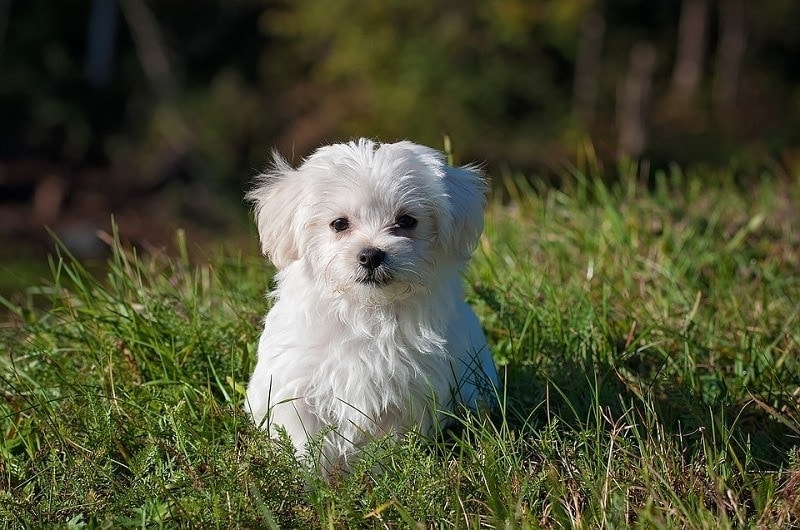
Gather the Supplies
You will definitely need a few supplies if you intend on doing most, if not all, of the grooming yourself.
- Dog shampoo (dog whitening shampoo, if possible)
- Detangling spray
- Pin brush
- Slicker brush
- Toothbrush and toothpaste for dogs
- Grooming scissors
- Nail trimmers or grinder
- Tear stain cleaner
- Electric clippers
The 10 Tips to Groom a Maltese
1. Start With a Detangling Spray
Start by purchasing a good detangling spray, which you should spray onto your Maltese’s coat before brushing. It’s essentially a leave-in conditioner that helps keep the coat moisturized.
You shouldn’t spray too much, just enough to make it easier for your brush to get through any mats or tangles. It also helps prevent breakage and split ends while brushing.
The Maltese have hair rather than fur, which is why it’s so silky and constantly grows, which also means it’s more prone to tangles. Avoid the face and only spray the body.

2. Brush With a Pin Brush
Brushing is an essential part of the upkeep of a Maltese, so you’ll want to invest in both a pin brush and a slicker brush.
Before brushing, run your fingers through your dog’s coat with your fingers. If there are any mats, gently work through the mat with the pin brush.
Then, continue using the pin brush to brush your dog’s coat, working it down with the natural growth. Start at the roots, and work your way gently through to the ends.
Pin brushes work well at removing mats and can help straighten the coat without creating any new tangles.
3. Follow With a Slicker Brush
Once you’ve finished with the pin brush, follow it with the slicker brush. At this point, the slicker brush should glide through the hair without getting snagged. This will remove any extra loose hair and tangles that you might have missed. You can also use a stainless-steel comb.
If there are stubborn mats, gently work through them with your fingers and with a spritz of the detangler. If you have difficulty removing one, you might need to carefully cut it out.
Mats can be painful if they aren’t removed because they pull the skin, so it’s crucial to stay on top of brushing so it doesn’t get to that point.
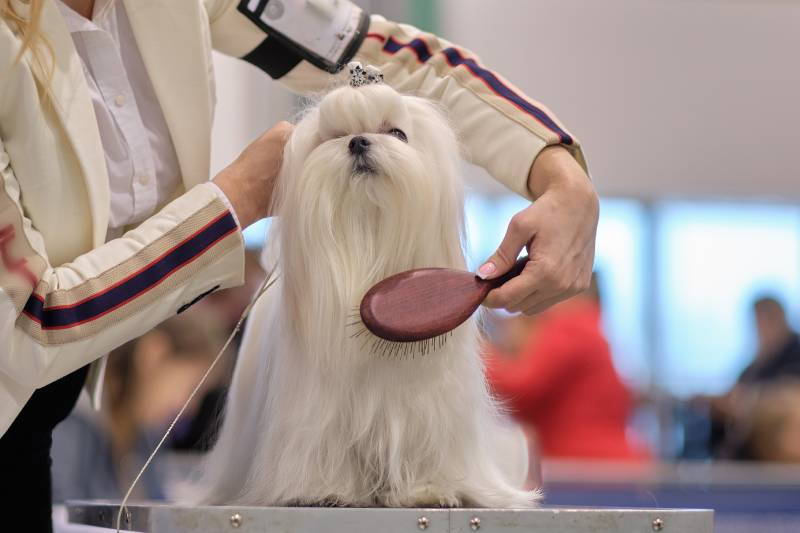
4. Bathe Them
Before giving your Maltese a bath, you should always brush them first. This dog doesn’t need frequent baths—maybe every 3 weeks or so or if they are particularly dirty or smelly. Too many baths can lead to dry and irritated skin.
Be sure to use a gentle shampoo formulated for dogs. A whitening shampoo can help keep your dog’s coat super white.
You can wash your dog in a sink due to their small size, but regardless of where you bathe them, start by thoroughly soaking the coat, then apply the shampoo and work it into a lather.
If you’re using a whitening shampoo, the directions might tell you to let it sit for a few minutes and then rinse well. You don’t want any residue left on the coat, as it will irritate the skin, and be sure to avoid the ears and eyes.
Once you’re finished, wrap your Maltese in a towel, and try to remove as much moisture as possible. If you’re going to blow dry your dog, set the unit to warm and dry the hair in sections.
Bathing your pet can be challenging, but the right shampoo will make it a lot easier! We have two favorite shampoos for the job, both are safe, all-natural shampoos designed with your pets in mind. Our soothing shampoos are pH balanced, made in the USA, and free of glutens, dyes, sulfates, and phthalates. Here’s a quick guide to help you choose the right option for your pet’s next bath!
 Hepper Colloidal Oatmeal Pet Shampoo |
 Hepper Waterless No Rinse Pet Shampoo |
|
|---|---|---|
| Natural cucumber & aloe scent |
Natural cucumber & aloe scent:
|
Natural cucumber & aloe scent:
|
| Safe for cats & dogs |
Safe for cats & dogs:
|
Safe for cats & dogs:
|
| Rinsing required |
Rinsing required:
|
Rinsing required:
|
| Free of harsh chemicals & nasty ingredients |
Free of harsh chemicals & nasty ingredients:
|
Free of harsh chemicals & nasty ingredients:
|
| Lathers easily |
Lathers easily:
|
Lathers easily:
|
5. Use Grooming Wipes
Grooming wipes are a great option for those times in between baths. They are a quick and easy way to keep those white coats white and your dog smelling fresh.
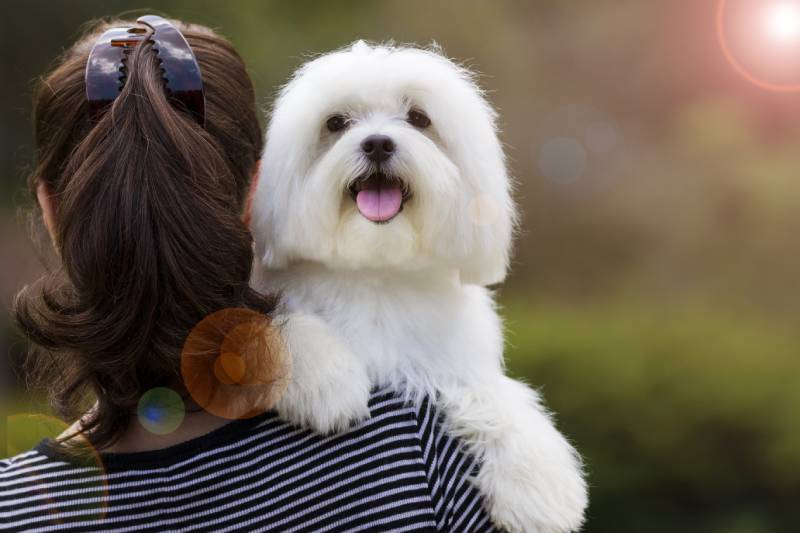
6. Wipe Their Face and Eyes
Tear stain cleaner can help your Maltese’s fur stay white around their eyes. These dogs are prone to developing tear stains, and you’ll only want to use something safe for use around the eyes. You’ll also need to focus on the mouth and chin.
7. Trim the Coat
There are many variations on how to trim your dog’s coat. You can opt to have your Maltese trimmed by a groomer every month or so, which will be easier and safer.
Otherwise, you might need to watch a few videos on how to clip your Maltese. If you leave their coats long, they will require more maintenance, particularly with brushing.
The hair grows long around the eyes, legs, paws, and ears, so these areas need more frequent trims. Your Maltese needs to be calm during grooming sessions because you don’t want to accidentally injure them.
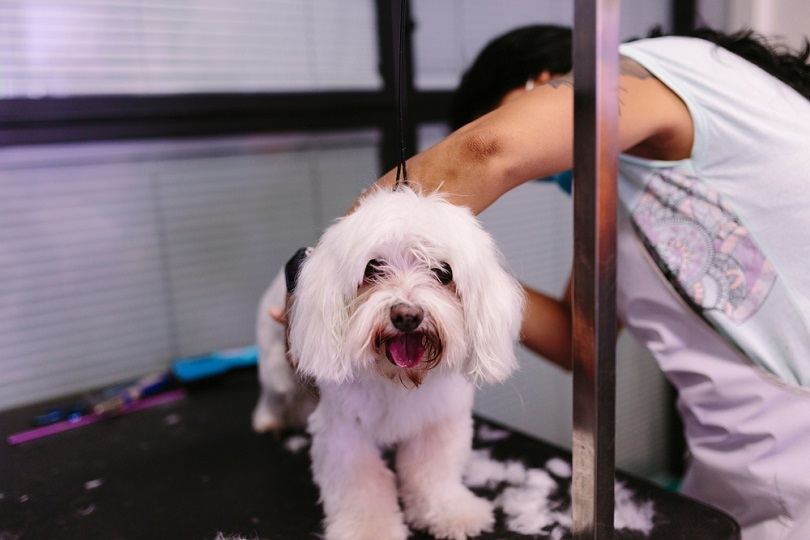
8. Take Care of the Ears
The ears need particular attention, so you’ll want to purchase an ear cleaner. Place a few drops in the ear, massage it gently, and wipe it clean with a cotton cloth or cotton balls. Don’t use Q-tips because they are more likely to push the dirt and wax farther into the ear.
The inside of the ears should also have the excess fur plucked regularly, but you’ll want to leave this to your groomer or ask your vet to learn how to do this correctly.
9. Look After the Paws
Trimming your dog’s nails should be done every 3 weeks or so, but it depends on your dog. If you can hear their nails clicking on the floor, that’s usually a good indication that it’s time for a trim.
You can use nail clippers meant for dogs or a nail grinder. Start by trimming a little at a time so you don’t accidentally hit the quick, which is a vein that runs through the dog’s nail.
You can get your Maltese more comfortable with the process by holding their paws without doing anything and then gradually building up to trimming a nail or two. Treats also help!
You should also carefully trim the excess hair between the toes and pads. This should only be done by you if your dog can stand still without moving around too much. Otherwise, leave it to a groomer.

10. Brush the Teeth
Finally, you’ll need to brush your dog’s teeth, which should be done at least twice a week. Only use toothpaste and a toothbrush meant for dogs. Human toothpaste has toxic ingredients, and the bristles of our toothbrushes are just not meant for dogs.
Brush using gentle circular motions, and pay particular attention to the back teeth, since this is where tartar tends to lurk the most. You’ll also want your Maltese to have their teeth professionally cleaned by your vet annually.
How Often Should You Groom Your Maltese?
The timeline depends on your dog and your own schedule, but the following sessions are generally recommended.
Daily
You should try to use facial wipes/eye wipes and brush your dog’s teeth every day. If your Maltese has a long coat, you’ll also want to use the detangler and brush them daily.

Every Other Day
If your Maltese has a medium-length coat, you’ll want to brush them every other day, and don’t forget the detangler!
Every 3 Days
If your Maltese has a short coat, you’ll only need to brush them once every 3 days. If they start to get a little oily but are not dirty enough to warrant a bath, you can use dog-safe dry shampoo on their coat.
Every 3 Weeks
Every 3 weeks, give your Maltese a bath. If they get particularly dirty and smelly beforehand, though, you should go ahead and bathe them. Don’t forget to brush before and after the bath, and only use dog shampoo.

Every 4 weeks
Focus on cleaning up your dog’s ears. They might not need plucking at this time; just check the density of the fur inside the ears.
Every 5 to 6 Weeks
Trim or grind your dog’s nails around this time. However, you don’t have to stick to this rigid schedule if they need trimming sooner.

Conclusion
The distinct advantage of owning the Maltese is their lack of shedding, and if anyone in your home is allergic to dogs, the Maltese might be the right breed for your family. They are also charming and loving dogs.
Regardless of the breed, all dogs need grooming; some just need more than others. It’s true that the Maltese do require more attention for their grooming needs than many other breeds, but once it becomes a part of your routine, you’ll likely find that you enjoy spending that time with your dog.
Featured Image Credit: Sushitsky Sergey, Shutterstock



